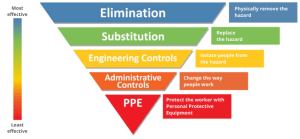On the 6 April 2022, the PPE regulations are changing. In this article we break down the key changes and steps your organisation needs to take in preparation.
What is PPE?
PPE – Personal Protective Equipment – is equipment used by an individual, such as gloves, boots and goggles, to reduce the likelihood of harm to them. PPE is referred to as the “last resort” on the hierarchy of controls, as it relies on the individual to wear the equipment correctly and to maintain it.
(Hierarchy of controls)
Read our article on What, Why and How we Should Use PPE and RPE, for more detailed information about PPE and the hierarchy of controls.
What are the changes to the PPE regulations?
The PPE regulations (PPER 1992) will be amended on the 6 April 2022 and become PPER 2022. The duties under these regulations, which include obligations to provide appropriate and correctly stored PPE equipment for free to workers, are unchanged, however, they are being extended to include limb (b) workers. These changes don’t apply to people who are self-employed.
Who are limb (b) workers?
Limb (a) workers are those employees with a contract of employment and are already under the scope of the PPER 1992 (and the HSWA 1974).
Limb (b) workers are those who have casual employment, work under a contract for service; and don’t currently fall under the PPER 1992. The amended regulations (PPER 2022) now includes these workers.
PPE requirements for employers of limb (b) workers
- You will need to provide PPE to your limb (b) workers, free of charge, as you do with your regular employees. You cannot charge workers for PPE they require to carry out the work.
- You will need to assess the risks posed to limb (b) workers, assess the PPE in relation to these risks and ensure its suitability.
- Once you have put suitable control measures such as engineering controls (please see hierarchy of controls), you must provide suitable, compatible PPE.
- Ensure the PPE is properly maintained, stored correctly and most importantly used
- As you would with your employees, you will need to provide training and instruction of the use of the PPE to all your workers.
Risk assessments for limb (b) workers
Risk assessments are an important part of PPE legislation. It‘s important to think about all potential hazards, who might be harmed and how, and review the assessment regularly.
We can help
Cardinus provide a range of online and on-site safety & DSE services, which can help your organisation with risk management and safety. For more information about any of our services, contact us today.



